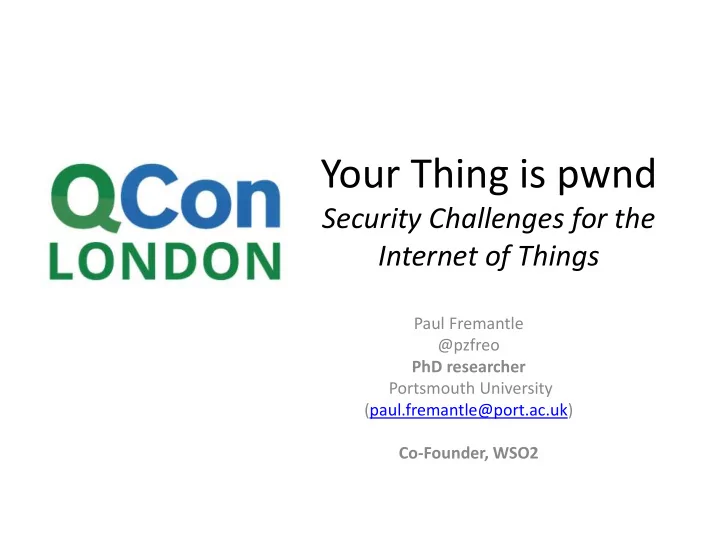

Your Thing is pwnd Security Challenges for the Internet of Things Paul Fremantle @pzfreo PhD researcher Portsmouth University (paul.fremantle@port.ac.uk) Co-Founder, WSO2
Firstly, does it even matter?
My three rules for IoT security • 1. Don’t be stupid • 2. Be smart • 3. Think about what’s different
My three rules for IoT security • 1. Don’t be stupid – The basics of Internet security haven’t gone away • 2. Be smart – Use the best practice from the Internet • 3. Think about what’s different – What are the unique challenges of your device?
“Google Hacking”
http://www.forbes.com/sites/kashmirhill/2013/07/26/smart-homes-hack/
1998 • Realized that session cookies needed to be tied to user sessions – Scenario: Attacker has a valid login, but changes their cookie – Gets access to another user’s account
February 2015 Mosquitto 1.4 Release Notes • When a durable client reconnects, its queued messages are now checked against ACLs in case of a change in username/ACL state since it last connected.
So what is different about IoT? • The longevity of the device – Updates are harder (or impossible) • The size of the device – Capabilities are limited – especially around crypto • The fact there is a device – Usually no UI for entering userids and passwords • The data – Often highly personal • The mindset – Appliance manufacturers don’t think like security experts – Embedded systems are often developed by grabbing existing chips, designs, etc
Physical Hacks A Practical Attack on the MIFARE Classic: http://www.cs.ru.nl/~flaviog/publications/Attack.MIFARE.pdf Karsten Nohl and Henryk Plotz. MIFARE, Little Security, Despite Obscurity
UltraReset https://intrepidusgroup.com/insight/2012/09/ultrareset-bypassing-nfc-access-control-with-your-smartphone/
Or try this at home? http://freo.me/1g15BiG
http://www.cl.cam.ac.uk/techreports/UCAM-CL-TR-630.html
Hardware recommendations • Don’t rely on obscurity
Hardware recommendations • Don’t rely on obscurity • Don’t rely on obscurity • Don’t rely on obscurity • Don’t rely on obscurity • Don’t rely on obscurity • Don’t rely on obscurity • Don’t rely on obscurity
Hardware Recommendation #2 • Unlocking a single device should risk only that device’s data
The Network
Crypto on small devices • Practical Considerations and Implementation Experiences in Securing Smart Object Networks – http://tools.ietf.org/html/draft-aks-crypto-sensors-02
ROM requirements
ECC is possible (and about fast enough)
Crypto Borrowed from Chris Swan: http://www.slideshare.net/cpswan/security-protocols-in-constrained-environments/13
Won’t ARM just solve this problem?
Cost matters 8 bits 32 bits $5 retail $25 retail $1 or less to embed $?? to embed
Another option?
SIMON and SPECK https://www.schneier.com/blog/archives/2013/07/simon_and_speck.html
Datagram Transport Layer Security (DTLS) • UDP based equivalent to TLS • https://tools.ietf.org/html/rfc4347
Key distribution
How do you distribute keys to devices? • Usually at manufacture time • Complex to update • What about expiration?
Passwords • Passwords suck for humans • They suck even more for devices
MQTT
Why Federated Identity for IoT? • Can enable a meaningful consent mechanism for sharing of device data • Giving a device a token to use on API calls better than giving it a password – Revokable – Granular • May be relevant for both – Device to cloud – Cloud to app
Why really? Your IoT data privacy should not rely on the maker of a specific device
Relying on the maker of your device?
Device to Cloud • Put an OAuth2 token on the device • Set the “scope” to be limited – This device can publish to this topic • Support refresh model
Cloud to App • The same technology can be used to enable some app to subscribe to a specific topic • Much easier than with Arduino!
Lessons learnt • OAuth2 Token lengths are usually ok (no promise though) – OpenId Connect much larger • Registration is hard • MQTT and MPU / I2C code is 97% of Duemilanove – Adding the final logic to do OAuth2 flow pushed it to 99% – No TLS in this demo is a big issue • Different OAuth2 implementations behave differently – Need to disable updating the refresh token with every refresh • Need to be able to update the scope of token if this will work for long term embedded devices • MQTT needs some better designed patterns for RPC – Standardised
More information http://pzf.fremantle.org/2013/11/using- http://siot-workshop.org/ oauth-20-with-mqtt.html
OpenId Connect
Are you creating the next privacy breach?
Summary • Think about security with your next device • We as a community need to make sure that the next generation of IoT devices are secure • We need to create exemplars – Shields – Libraries – Server software – Standards
http://upload.wikimedia.org/wikipedia/commons/c/c8/Thank_you_001.jpg
Recommend
More recommend